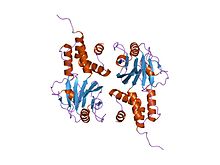- Creb binding domain
-
Creb binding 
irf3-cbp complex Identifiers Symbol Creb_binding Pfam PF09030 InterPro IPR014744 Available protein structures: Pfam structures PDB RCSB PDB; PDBe PDBsum structure summary In molecular biology, the creb binding domain is a protein domain. It is the interlocking domain of the eukaryotic nuclear receptor coactivators CREBBP and P300. This interlocking domain forms a 3-helical non-globular array that forms interlocked heterodimers with its target.
Nuclear receptors are ligand-activated transcription factors involved in the regulation of many processes, including development, reproduction and homeostasis. Nuclear receptor coactivators act to modulate the function of nuclear receptors. Coactivators associate with promoters and enhancers primarily through protein-protein contacts to facilitate the interaction between DNA-bound transcription factors and the transcription machinery. Many of these coactivators are structurally related, including CBP (CREB-binding protein, CREBBP) and P300.[1] CBP and P300 both have histone acetyltransferase activity. CBP/P300 proteins function synergistically to activate transcription, acting to remodel chromatin and to recruit RNA polymerase II and the basal transcription machinery. CBP is required for proper cell cycle control, differentiation and apoptosis. The interaction of CBP/P300 with transcription factors involves several small domains. The IBiD domain in the C-terminal of CBP is responsible for CBP interaction with IRF-3, as well as with the adenoviral oncoprotein E1A, TIF-2 coactivator, and the IRF homologue KSHV IRF-1.[2]
References
- ^ Demarest SJ, Martinez-Yamout M, Chung J, Chen H, Xu W, Dyson HJ, Evans RM, Wright PE (January 2002). "Mutual synergistic folding in recruitment of CBP/p300 by p160 nuclear receptor coactivators". Nature 415 (6871): 549–53. doi:10.1038/415549a. PMID 11823864.
- ^ Lin CH, Hare BJ, Wagner G, Harrison SC, Maniatis T, Fraenkel E (September 2001). "A small domain of CBP/p300 binds diverse proteins: solution structure and functional studies". Mol. Cell 8 (3): 581–90. doi:10.1016/S1097-2765(01)00333-1. PMID 11583620.
This article includes text from the public domain Pfam and InterPro IPR014744
Categories:- Protein domains
Wikimedia Foundation. 2010.
